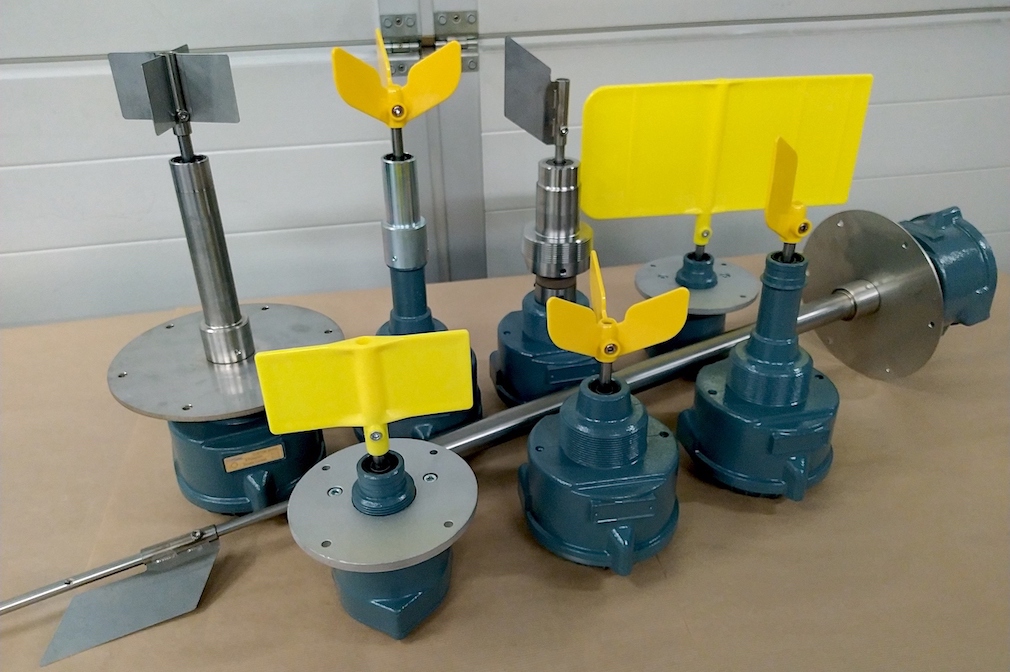
Reducing the elastic force of the spring allows a rotary indicator to detect materials with lower specific gravity, but it could also increase the risk of false signals because the spring would be too weak to return the motor to its initial position.
Bearing this possibility in mind, to maintain a high standard of reliability, CAMLogic identified the way to go to increase the sensitivity of the instrument towards low density materials without risking any malfunctions.
THE OPERATION OF A ROTARY LEVEL INDICATOR
The correct operation of a rotary level indicator is an equilibrium of different forces:
- compression force of the microswitch on the signal circuit;
- force exerted by the motor return spring;
- resistance torque due to seals and bearings;
- reactional torque of the paddle on the material to be detected.
In fact, we act on the reactional torque of the paddle on the material, modifying shape and size. With the increase in the friction surface of the paddle, the number of blades or the range, an increase of the reactional torque of the paddle on the material is obtained.

5 FACTORS TO CONSIDER TO CHOOSE THE RIGHT PADDLE
Choosing a suitable paddle is fundamental for the correct operation of the instrument. The factors to consider are listed and detailed below.
1. MINIMUM DENSITY
Every material has a minimum density to consider when choosing the paddle, that should have the ability to detect a minimum density greater than or equal to that of the material.
It is therefore not recommended to choose a propeller suitable for medium-heavy materials to detect very light materials such as ash, because the propeller might not have the necessary and sufficient friction surface to detect it and would spin idly “digging” a niche.
However, all the paddles suitable for light materials work well even for heavier ones, provided that they are adequately protected from the direct fall or the weight of the material, especially for the minimum level indicators. In such cases it is always necessary to provide a protection for the part of the indicator inside the silo (paddle and possible extension).
2. MINIMUM INSTALLATION DIAMETER
In all cases where it is not possible to mount the paddle from the inside, it is necessary to keep in mind the minimum installation diameter, that is the size of the smallest passage hole that the paddle is able to pass through.
The one bladed versions generally go through small diameters, whereas those with more blades require larger installation holes.
3. PADDLE DIAMETER DURING ROTATION
The paddle must be able to rotate freely along its trajectory, without encountering obstacles such as the walls of the silo, protections or reinforcements. The paddle diameter is simply the diameter of the ideal cylinder occupied by the paddle during its complete rotation.
4. NUMBER OF BLADES
When installed inside cyclonic filters, or wherever strong air currents are present, it is advisable to choose paddles with 2 or 3 blades in order to have a greater balance of aerodynamic forces and avoid false signals from the rotary level indicator.
5. MATERIAL
Plastic paddles are a good compromise between economy and durability and, in case of traditional installations, they are the best choice. CAMLogic plastic paddles are made of PA6 polyamide to ensure high mechanical resistance, together with a good chemical and abrasion resistance.
In all those cases requiring particular performances, such as high mechanical properties, high temperature use or risk of a buildup of static electricity, it is possible to opt for stainless steel paddles made of EN 1.4403 (AISI 304) also suitable for food contact.
All the paddles are interchangeable on the different rotary level indicator models (PGF05, PFG57, PFG09). Discover the entire range or contact us to find the most suited choice for your plant.
